 | | | Switch to: Europe, USA, New Zealand, Antarctica Credit: NOAA/Ovation  Planetary K-index Planetary K-index
Now: Kp= 2 quiet
24-hr max: Kp= 4 unsettled
explanation | more data
Interplanetary Mag. Field
Btotal: 4.0 nT
Bz: 0.3 nT north
more data: ACE, DSCOVR
Updated: Today at 2350 UT  Coronal Holes: 06 Aug 17 Coronal Holes: 06 Aug 17 
Earth is inside a stream of solar wind flowing from the indicated coronal hole. Credit: NASA/SDO.  Noctilucent Clouds They're back! Images of noctilucent clouds from NASA's AIM spacecraft are available again. The spacecraft's orbit had recently changed, requiring a new way to point AIM's science instruments. This problem has now been solved, and "daily daisies" have returned to Spaceweather.com. Switch view: Europe, USA, Asia, Polar Updated at: 08-06-2017 21:55:03 Noctilucent Clouds They're back! Images of noctilucent clouds from NASA's AIM spacecraft are available again. The spacecraft's orbit had recently changed, requiring a new way to point AIM's science instruments. This problem has now been solved, and "daily daisies" have returned to Spaceweather.com. Switch view: Europe, USA, Asia, Polar Updated at: 08-06-2017 21:55:03  SPACE WEATHER
NOAA Forecasts | | Updated at: 2017 Aug 06 2200 UTC FLARE | 0-24 hr | 24-48 hr | CLASS M | 01 % | 01 % | CLASS X | 01 % | 01 % |  Geomagnetic Storms: Geomagnetic Storms:
Probabilities for significant disturbances in Earth's magnetic field are given for three activity levels: active, minor storm, severe storm Updated at: 2017 Aug 06 2200 UTC Mid-latitudes | 0-24 hr | 24-48 hr | ACTIVE | 15 % | 30 % | MINOR | 05 % | 10 % | SEVERE | 01 % | 01 % | High latitudes | 0-24 hr | 24-48 hr | ACTIVE | 15 % | 15 % | MINOR | 25 % | 30 % | SEVERE | 25 % | 40 % | | | |  | | | | | | | | | | | Lights Over lapland is excited to announce that Autumn Aurora Adventures are available for immediate booking! Reserve your adventure of a lifetime in Abisko National Park, Sweden today! | | | SOLAR WIND, SUBSIDING: Earth is exiting a stream of fast-moving solar wind that sparked bright auroras over Canada when it first arrived three days ago. NOAA forecasters say there is a 45% chance of minor geomagnetic storms on Aug. 6th, declining to 25% on Aug. 7th. Free: Aurora Alerts PARTIAL LUNAR ECLIPSE: On Monday, Aug. 7th, the Moon will pass through the shadow of Earth, slightly off-center, producing a partial lunar eclipse. At maximum (1820 UT), about 25% of the lunar disk will be in shadow. The 2-hour event is best seen from India, China, Australia, and other countries of Earth's eastern hemisphere. This animation created by graphic artist Larry Koehn shows how the Moon's appearance will change: Sky watchers in the Americas will see ... just an ordinary full Moon, completely illuminated. According to folklore, it's the Sturgeon Moon, named by Native American tribes of the Great Lakes who caught lots of these fish during the month of August. Lake sturgeon are considered to be living fossils because they have survived virtually unchanged for more than 150 million years. A full Moon named after an ancient slimy fish? It's prettier than it sounds. 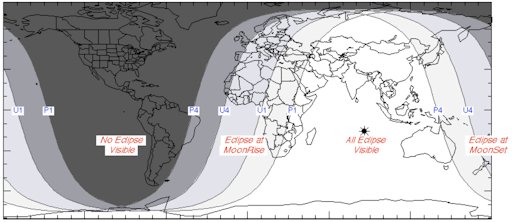
North Americans who miss this eclipse will get a great consolation prize two weeks from now: A total eclipse of the sun. On Aug. 21, 2017, the new Moon will pass directly in front of the sun. The Moon's cool dark shadow will lance down and touch the surface of the Earth, raking the USA from Oregon to South Carolina. People inside the path of totality will see the rarest of celestial wonders: Baily's beads, the Diamond Ring, and the sun's ghostly corona. Check ShadowandSubstance.com for a complete set of animated maps. Realtime Aurora Photo Gallery SOLAR ECLIPSE PENDANTS: Would you like to support our Solar Eclipse Balloon Network? Here's one way: Buy a space pendant. This solar eclipse-themed necklace flew to the stratosphere on July 2, 2017, attached to the payload of an Earth to Sky Calculus space weather balloon: 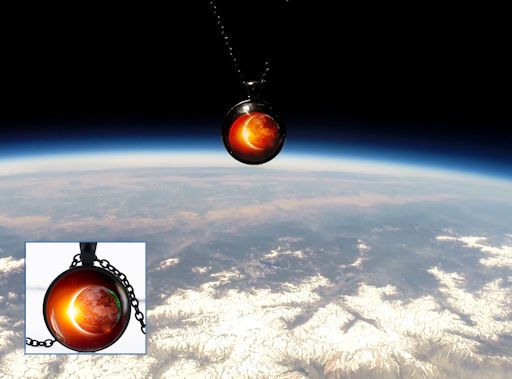
The payload contained more just like it. If you buy one now for $89.95, we will fly it back to the stratosphere during the Great American Solar Eclipse on August 21, 2017, where it will be enveloped by the Moon's cool shadow above our launch site in Oregon. No additional charge! Just make a note in the COMMENTS BOX of the shopping cart: "Please fly my pendant into the eclipse!" Each pendant comes with a greeting card showing the jewelry in flight and telling the story of its journey to the stratosphere and back again. More items from the edge of space may be found in the Earth to Sky Store. All proceeds support atmospheric radiation monitoring and hands-on STEM education. Far Out Gifts: Earth to Sky Store
All proceeds support hands-on STEM education THE MAGNETIC TENTACLES OF SUNSPOT AR2670: This morning in Uzès, France, amateur astronomer JP Brahic looked down through the eyepiece of his safely-filtered telescope at sunspot AR2670. He saw two magnetic tentacles reaching back: 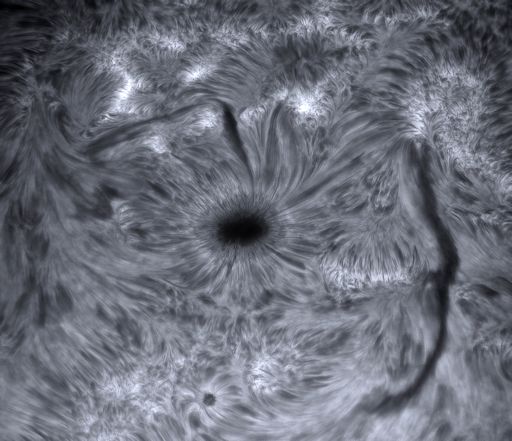
The spider-like extensions thread the sun's atmosphere high above the sunspot's dark Earth-sized core. "Their scale makes them easy targets for backyard solar telescopes," says Stuart Green who also photographed them from Preston, Lancashire, UK.
The underlying sunspot has been quiet for days, but if these magnetic structures happen to criss-cross above it, there could be a ferocious explosion caused by magnetic reconnection. This possibility makes AR2670 worth monitoring as it crosses the face of the sun in the days ahead. Realtime Space Weather Photo Gallery
Realtime Noctilucent Cloud Photo Gallery
Every night, a network of NASA all-sky cameras scans the skies above the United States for meteoritic fireballs. Automated software maintained by NASA's Meteoroid Environment Office calculates their orbits, velocity, penetration depth in Earth's atmosphere and many other characteristics. Daily results are presented here on Spaceweather.com. On Aug. 6, 2017, the network reported 39 fireballs.
(19 sporadics, 16 Perseids, 3 Southern delta Aquariids, 1 alpha Capricornid)  In this diagram of the inner solar system, all of the fireball orbits intersect at a single point--Earth. The orbits are color-coded by velocity, from slow (red) to fast (blue). [Larger image] [movies] Potentially Hazardous Asteroids ( PHAs) are space rocks larger than approximately 100m that can come closer to Earth than 0.05 AU. None of the known PHAs is on a collision course with our planet, although astronomers are finding new ones all the time. On August 6, 2017 there were 1803 potentially hazardous asteroids.  | Recent & Upcoming Earth-asteroid encounters: | Asteroid | Date(UT) | Miss Distance | Velocity (km/s) | Diameter (m) | | 2011 CC22 | 2017-Aug-04 | 15.5 LD | 18.4 | 186 | | 2017 NB7 | 2017-Aug-06 | 6.9 LD | 6 | 80 | | 2017 OF7 | 2017-Aug-10 | 19.2 LD | 8.1 | 88 | | 2014 OA339 | 2017-Aug-13 | 12.3 LD | 10 | 47 | | 2017 PE | 2017-Aug-24 | 19.5 LD | 7.1 | 46 | | 3122 | 2017-Sep-01 | 18.5 LD | 13.5 | 5376 | | 2014 RC | 2017-Sep-11 | 15.1 LD | 8.9 | 16 | | 1989 VB | 2017-Sep-29 | 7.9 LD | 6.3 | 408 | Notes: LD means "Lunar Distance." 1 LD = 384,401 km, the distance between Earth and the Moon. 1 LD also equals 0.00256 AU. MAG is the visual magnitude of the asteroid on the date of closest approach. | | Cosmic Rays in the Atmosphere |
Readers, thank you for your patience while we continue to develop this new section of Spaceweather.com. We've been working to streamline our data reduction, allowing us to post results from balloon flights much more rapidly, and we have developed a new data product, shown here: 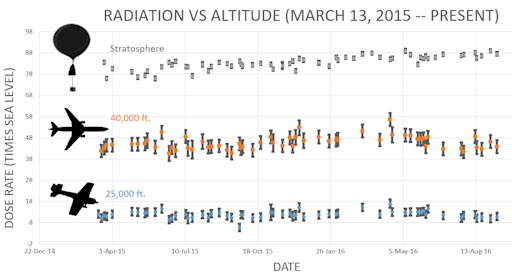
This plot displays radiation measurements not only in the stratosphere, but also at aviation altitudes. Dose rates are expessed as multiples of sea level. For instance, we see that boarding a plane that flies at 25,000 feet exposes passengers to dose rates ~10x higher than sea level. At 40,000 feet, the multiplier is closer to 50x. These measurements are made by our usual cosmic ray payload as it passes through aviation altitudes en route to the stratosphere over California. What is this all about? Approximately once a week, Spaceweather.com and the students of Earth to Sky Calculus fly space weather balloons to the stratosphere over California. These balloons are equipped with radiation sensors that detect cosmic rays, a surprisingly "down to Earth" form of space weather. Cosmic rays can seed clouds, trigger lightning, and penetrate commercial airplanes. Furthermore, there are studies ( #1, #2, #3, #4) linking cosmic rays with cardiac arrhythmias and sudden cardiac death in the general population. Our latest measurements show that cosmic rays are intensifying, with an increase of more than 13% since 2015: 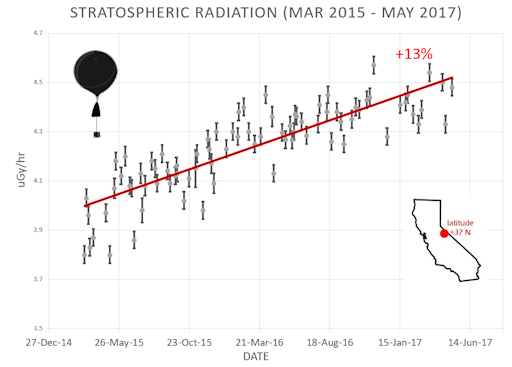
Why are cosmic rays intensifying? The main reason is the sun. Solar storm clouds such as coronal mass ejections (CMEs) sweep aside cosmic rays when they pass by Earth. During Solar Maximum, CMEs are abundant and cosmic rays are held at bay. Now, however, the solar cycle is swinging toward Solar Minimum, allowing cosmic rays to return. Another reason could be the weakening of Earth's magnetic field, which helps protect us from deep-space radiation. The radiation sensors onboard our helium balloons detect X-rays and gamma-rays in the energy range 10 keV to 20 MeV. These energies span the range of medical X-ray machines and airport security scanners. The data points in the graph above correspond to the peak of the Reneger-Pfotzer maximum, which lies about 67,000 feet above central California. When cosmic rays crash into Earth's atmosphere, they produce a spray of secondary particles that is most intense at the entrance to the stratosphere. Physicists Eric Reneger and Georg Pfotzer discovered the maximum using balloons in the 1930s and it is what we are measuring today. | | The official U.S. government space weather bureau | | | The first place to look for information about sundogs, pillars, rainbows and related phenomena. | | | Researchers call it a "Hubble for the sun." SDO is the most advanced solar observatory ever. | | | 3D views of the sun from NASA's Solar and Terrestrial Relations Observatory | | | Realtime and archival images of the Sun from SOHO. | | | from the NOAA Space Environment Center | | | a proud supporter of science education and Spaceweather.com | | | fun to read, but should be taken with a grain of salt! Forecasts looking ahead more than a few days are often wrong. | | | from the NOAA Space Environment Center | | | the underlying science of space weather |  | Beautyz for top beauty products reviews and their buying guides |  | Reviews here can help you to pick up best memory foam mattresses. | | | These links help Spaceweather.com stay online. Thank you to our supporters! | | | | | | | | |  | |  |   | ©2017 Spaceweather.com. All rights reserved. This site is penned daily by Dr. Tony Phillips. | |

